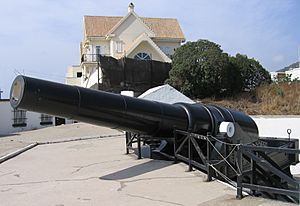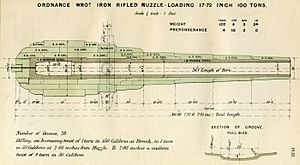100-ton gun facts for kids
Quick facts for kids Armstrong 100-ton gun |
|
|---|---|

"Rockbuster" at Napier of Magdala Battery, Gibraltar
|
|
| Type | Naval gun Coast defence gun |
| Place of origin | United Kingdom |
| Service history | |
| In service | 1877-1906 |
| Production history | |
| Designer | Elswick Ordnance Company |
| Unit cost | £16,000 (£176,000 today) |
| No. built | 15 |
| Specifications | |
| Mass | 103 tons |
| Barrel length | bore: 362.9 inches (9.22 m) (20.5 calibres) |
|
|
|
| Shell | HE, AP, Shrapnel, 2,000 pounds (910 kg) |
| Calibre | 450-millimetre (17.72 in) |
| Recoil | 1.75 m |
| Elevation | 10° 30' |
| Traverse | 150° |
| Muzzle velocity | 1,548 feet per second (472 m/s) |
| Maximum firing range | 6,600 yards (6,000 m) |
The 100-ton gun (also known as the Armstrong 100-ton gun) was a giant cannon made by a British company called Elswick Ordnance Company. This company was part of Armstrong Whitworth, owned by William Armstrong. It was a special type of gun called a rifled muzzle-loading (RML) gun.
Only 15 of these huge guns were ever built. They were used to arm two Italian battleships. To protect themselves from these powerful ships, the British also placed these guns in their forts at Malta and Gibraltar.
Contents
Why Build Such a Big Gun?
Around 1870, the biggest guns in the UK weighed about 38 tons. They could fire a heavy projectile that could break through thick steel armor. But gun technology was improving very quickly! Soon, French companies made even bigger guns, weighing 76 tons.
This made the British Royal Navy want an even larger gun, weighing 80 tons. Armstrong, a major British gun maker, decided to create an even bigger weapon. They designed an 18-inch (450 mm) gun, which became known as the '100-ton gun'. Armstrong offered it to the Royal Navy, but they thought it was too heavy and expensive.
What Was the 100-Ton Gun Like?
These new guns were enormous for their time. They weighed as much as the huge guns on much later battleships. But their barrels were quite short. They were muzzle-loading guns, meaning ammunition was loaded from the front. They also had a special "rifled" barrel to make the shells spin and fly straight.
Each gun needed a large crew of 35 people to operate it. This included 18 people just to handle the heavy ammunition!
The gun was almost 10 meters (33 feet) long. Its widest part was nearly 2 meters (6.5 feet) across. The gun was built in a very complex way. It had an inner steel tube surrounded by many layers of wrought iron coils. The total weight of the gun was about 103,888 kg, which is roughly 100 tons.
The gun could be fired using mechanical or electrical systems. It also had an optical system to help with aiming. The crew could fire a projectile about once every six minutes. A shell could travel up to 5,990 meters (about 3.7 miles). Even at that distance, the projectile could still break through 394 mm (about 15.5 inches) of steel armor.
The gun's mount was also very heavy. It weighed over 20,000 kg (20 tons). This mount had 18 wheels to help move the gun. Hydraulic systems were used to turn the gun and raise or lower its barrel.
Ammunition for the 100-Ton Gun
The 100-ton gun used special ammunition. It had a "polygroove rifling" system, which helped the shells spin correctly as they left the barrel.
There were three main types of projectiles, all weighing about 2,000 pounds (907 kg) and measuring 17.7 inches (450 mm) across:
- Armour-piercing (AP) shells: These were designed to break through enemy ship armor. They were about 1.12 meters (44 inches) long. They could pierce 21 inches (530 mm) of steel at 1,800 meters. They also had a small explosive charge inside.
- High explosive (HE) shells: These shells had thinner walls and a larger explosive charge. They were designed to cause a lot of damage when they exploded.
- Shrapnel shells: These shells had a small explosive charge but were filled with 920 small bullets. When they exploded, they would spray these bullets over a wide area, harming many enemy soldiers.
The firing charges were made of a special propellant. Four or five of these charges were needed to fire a shell at maximum power. When the gun fired, it would recoil (kick back) about 1.75 meters (5.7 feet). Two hydraulic pistons helped absorb this powerful recoil.
Where Were They Used?
Sold to Italy
After Italy became a united country, its navy, the Regia Marina, wanted to build the best and most powerful battleships. They started with the Duilio-class ships, which had very powerful guns. But in 1874, when the UK began building a ship with even bigger guns, Italy wanted to stay ahead.
So, on July 21, 1874, Armstrong signed a contract with Italy. They agreed to deliver eight 100-ton guns. These guns were enough to arm the battleships Duilio and her sister ship Dandolo. During tests in 1880, one of Duilios guns cracked while firing at full power. After this, it was decided that the maximum safe firing charge was a bit less than originally planned.
The Guns That Still Exist
The 100-ton guns at Napier of Magdala Battery in Gibraltar and at Fort Rinella in Malta are still there today. You can visit them! These guns were too expensive to destroy, so they were left as they were. Later, both were restored so people could see them. Fort Rinella is looked after by a group called Fondazzjoni Wirt Artna. The gun at Fort Rinella was painted pink recently, but originally, these guns were not painted at all.
Gallery






